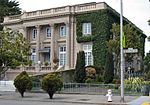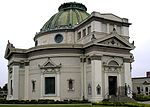Lone Mountain Cemetery

Lone Mountain Cemetery was a complex of cemeteries in the Lone Mountain neighborhood of San Francisco, California on the land bounded by the present-day California Street, Geary Boulevard, Parker Avenue, and Presidio Avenue. Opened 1854, it eventually comprised Laurel Hill Cemetery, Calvary Cemetery, the Masonic Cemetery, and Odd Fellows Cemetery.Pressure to close the complex began around the beginning of the twentieth century, and by 1941 all remains within it had been moved elsewhere, mostly to a new necropolis in Colma, California, though some were never accounted for.The land from Laurel Hill Cemetery and Calvary Cemetery was eventually used to create housing and shopping centers within the Lone Mountain neighborhood, the Masonic Cemetery land became the campus for University of San Francisco (USF), and the Odd Fellows Cemetery had maintained the columbarium and surrounding memorial park land, and the additional land was used to create the Angelo Rossi Playground and Pool and some single family housing.
Excerpt from the Wikipedia article Lone Mountain Cemetery (License: CC BY-SA 3.0, Authors, Images).Lone Mountain Cemetery
Euclid Avenue, San Francisco
Geographical coordinates (GPS) Address Nearby Places Show on map
Geographical coordinates (GPS)
| Latitude | Longitude |
|---|---|
| N 37.78413 ° | E -122.45087 ° |
Address
Euclid Avenue 280
94118 San Francisco
California, United States
Open on Google Maps







